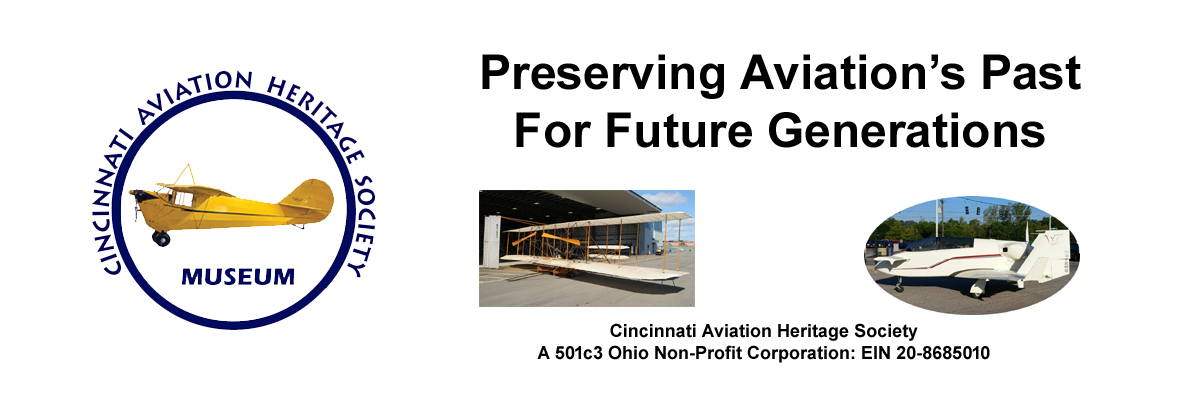Raven Rock Airport
By Charlie Pyles
One of our members brought forward some information about this airport pointing to an on line video site that was a spoof. After I did some digging, I learned that the spoof contained some good information and that's what I'll share with you.
Raven Rock airport was apparently used as early as 1912 when airships must have visited from time to time. There is reference to such a visit in Roy E. Vastine's 'A History of Scioto County' c.1986.
Raven Rock Airport developed over the years in a valley along the Ohio River below a local landmark with the same name. Below is a photo of the airport during a dedication of the airport probably around 1928 according to the caption.

You can see a Curtiss-Wright Company Ford Tri-Motor operating on the runway in this photo and a good sized crowd lined up along the runway. This photo is taken from atop the landmark looking down on the airport.
Raven Rock remained in operation through 1957 when the new Portsmouth Scioto County Airport opened just North of town in the community of Minford. A 4,300' runway opened to traffic in the new modern day facility. This happens to be the airport where I started my own airline career with Lake Central Airlines September 10th, 1963.
More information is needed about Raven Rock and the Airport at Minford. If you have photos or stories you're willing to share, please contact me by clicking here. I have more information on Raven Rock including pictures when I get permission to use them.
When a Piper Cub Landed in a Tree
By Eugenia M. Kenyon
My husband met and knew personally Mr. William T. Piper, of Piper Aircraft Co., during trips to the factory in Lock Haven, PA. In connection with Mr. Piper, an incident comes to mind. Sometime in the early 1940's an experiment was tried at the Raven Rock Airport in Portsmouth, OH. Mr. Piper, accompanied by some others from Lock Haven, were on hand to see a Piper Cub cut its motor and land by parachute. All went according to plan, except a crosswind drifted the plane into some trees on a hillside, where it dangled, parachute and all, until the pilot was rescued. (I don't recall how the plane got down.) It was quite exciting and colorful at the time, but loses some of its luster in telling. This experiment was for some practical purpose in connection with the war effort.
This event was recounted by my late mother, Eugenia M. Kenyon, in a letter dated February 9, 1962, addressed to Tom Hamer, Aviation Editor of the Huntington, WV Herald Dispatch.
William T. Piper (1881-1970), known as "the Henry Ford of aviation," was the founder, eponym and president of Piper Aircraft Corporation from its inception in 1929 until 1970. The company had its origin in the Taylor Brothers Airplane Manufacturing Company, founded in 1927. In 1930, the company filed for bankruptcy and William T. Piper purchased its assets for $761. Piper believed that a simple-to-operate, low-cost private airplane would flourish, even in the depths of the Depression. The Piper J-3 Cub, adapted from the Taylor J-2 Cub, was introduced in 1937 and proved Piper right: a total of 19,888 J-3 Cubs were built until production ceased in 1947. Prices ranged from $995 to $2,461 when new.
Production of Piper aircraft continued through the Second World War: at one point, the factory was completing one J-3 Cub every 20 minutes. After the war ended, Piper manufactured private aircraft until 1969, when the Piper family sold the business. Today, Piper Aircraft, Inc. is privately held and constructs jet- and propeller-driven aircraft at its facility in Vero Beach, FL.
Raven Rock Airport was located in Portsmouth, Scioto County, OH. The airport was in a valley along the Ohio river below a local landmark named Raven Rock, an oddly-shaped rock outcropping on a cliff. According to the Cincinnati Aviation Heritage Society, the airport was apparently used as early as 1912 by airships flying cross-country. It was officially dedicated around 1928 and remained in operation until 1957.
With respect to the experiment witnessed and described by my mother, although this particular attempt was unsuccessful, it was a precursor of a parachute-based aircraft recovery system developed 40 years later.
In 1980 Boris Popov, of St. Paul, MN, invented a parachute system designed to slowly lower an airplane to the ground relatively safely for the pilot and passengers. The idea came to Popov after he sustained injuries in a 400-foot fall in a partly-collapsed hang glider. Popov's ballistic recovery system [BRS] could be used in the event of loss of control, failure of the aircraft structure or other in-flight emergencies.
In Popov's system, a solid-fuel rocket is used to pull the parachute out of its housing and deploy the canopy within a few seconds.
Popov founded his company, now known as BRS Aerospace, in 1980, and marketed his first model in 1982. It was intended to be attached to ultra-light aircraft. In 1983, a pilot in Colorado survived an accident in the first reported use of the system. In 1998, the company collaborated with Cirrus Design and received certification to market a ballistic recovery system for the Cessna 172. These systems are now authorized for use in many light, sport aircraft. According to a counter on the its website, as of September 30, 2011, a total of 266 lives had been saved by the use of BRS products.


